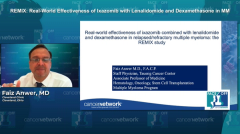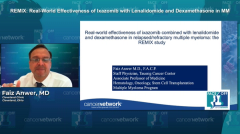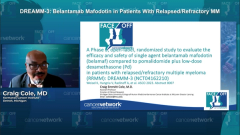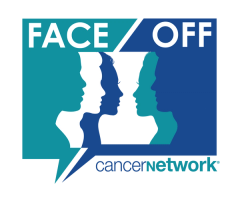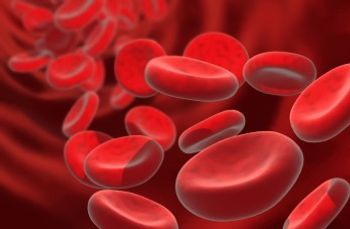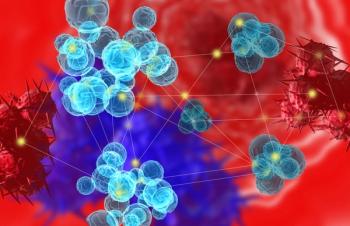
ALLIANCE A061202: Ixazomib Plus Pomalidomide and Dexamethasone in Multiple Myeloma
Andrew Kin, MD, reviews data on the addition of ixazomib to pomalidomide and dexamethasone in patients with multiple myeloma who progressed on lenalidomide in the first line.
Episodes in this series

Transcript:
Judy Schreiber, PhD, RN: We’re going to start with Dr Kin presenting on ixazomib, pomalidomide, and dexamethasone and the ALLIANCE A061202 trial [NCT02004275].
Andrew Kin, MD: Thank you. And again, thank you to the Cancer Network for hosting this Face-Off. Tonight I’ll be presenting the data on ixazomib, plus pomalidomide, and dexamethasone improving progression-free survival [PFS] for myeloma patients who have progressed on lenolitamide as part of their first-line therapy. This is the ALLIANCE A061202 study presented in abstract first at ESMO [the European Society for Medical Oncology annual meeting] in 2022, and with some updated data from which these slides are primarily taken from IMS [the International Myeloma Society annual meeting] last year, pending the official publication. So briefly as a study treatment overview, as I said, this is a patient who has progressed on lenalidomide typically as their first line of therapy. Often with lenalidomide maintenance, and are now little lenalidomide refractory, pomalidomide naive, proteasome inhibitors naive, or sensitive, they could have been exposed as part of their prior line, but not immediately refractory and had to be in good performance status of a 2 or better.
These patients were then randomized to the backbone control arm of pomalidomide, 4 [mg] dosing, 21 days on in a 28-day cycle with dexamethasone 40 mg weekly dose reduced as necessary for [patients] aged [older] than 75 [year]. The randomization was added on top of that backbone. Ixazomib, 4-mg weekly dosing, and was fairly well split. There were 39 patients treated in the comparison arm vs 38 patients in the active arm. The primary end point of the study was PFS. Patients were treated till progression and secondary and exploratory end points they were looking at were overall survival [OS], overall response rate, and clinical benefit rate, which is stable disease plus overall response rate as well as safety data.
You can see from the graph the triplet arm combination with ixazomib did quite a bit better. The median PFS in this arm was 20.35 months vs the comparison pom/dex [pomalidomide and dexamethasone] arm, which was 7.5 months. The hazard ratio of these curves is 0.377, and that was statistically significant with a P [value] less than .02.
The secondary end points of the OS median had not been reached for either of these arms. The overall response rate was much higher as well in the triplet therapy, 63% vs 43.6% in the doublet comparator. The VGPR [very good partial response] rate was significantly better as well, 26% vs [approximately] 5% with the doublet. The clinical benefit rate, so stable disease plus PR [partial response] or better, was almost 74% in the triplet arm vs 56% in the doublet comparison.
With the safety data, there were…no new safety signals out of the known published data for these regimens, adding extra medications does increase the degree of cytopenias, as shown with grade 3 and grade 4 [adverse events]. Lymphopenia, neutropenia, and anemia are slightly worse in the triplet arm compared [with] the doublet. Fatigue was about the same in grades 3 and 4 at about 15% each. Discontinuation, though, was quite a bit higher in the doublet arm with pom/dex. 77% compared [with] about 47% with disease progression, and the adverse events overall leading to discontinuation were similar. So combination has more cytopenias but not necessarily any significantly more adverse events.
In conclusion, the triplet therapy with ixazomib significantly increased the PFS when compared to the doublet comparator of pomalidomide and dexamethasone. It was a fairly well-tolerated regimen, with no new safety signals, and, perhaps most importantly, this is an all-oral regimen,…conducted primarily during the COVID-19 era. And now in the post–COVID-19 era perhaps focusing more on patient convenience there is a pretty significant advantage to this regimen compared [with] other options in the second-line setting and beyond.
Transcript is AI-generated and edited for clarity and readability.
Newsletter
Stay up to date on recent advances in the multidisciplinary approach to cancer.






